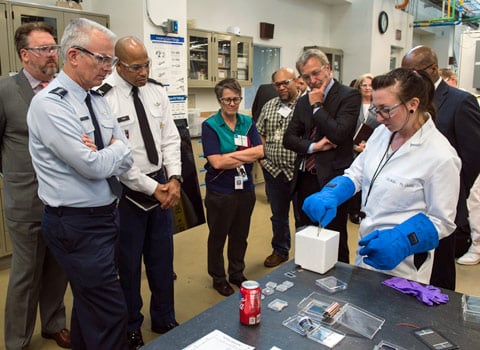National Security and Defense Partnerships
NLR and its U.S. national security and defense partners work to understand and inform research about novel and emerging threats to U.S. and international energy security.
Our work also:
- Enhances resilience of regional and installation energy infrastructure
- Incorporates core research into unique operational energy and mission requirements.
Since 1996, NLR has provided energy and resilience support to the U.S. Department of Defense (DOD) and the U.S. Department of Homeland Security (DHS) Office of the Chief Readiness Support Officer. NLR's DHS partnership includes training, policy and guidance, and technical assistance for energy, water, facilities, transportation, and resilience.
NLR has also supported DHS' unique operational energy needs by conducting research into remote power systems for border monitoring and planning the application of energy resources to enhance national security missions.
NLR's support to DOD includes analysis to inform energy efficiency, advanced energy, and energy-efficient transportation deployment; microgrid design to increase installation resilience; and aviation, maritime, and space-based energy solutions to reduce operational logistics tails.
National security and defense partners include DOD, DHS, the U.S. Department of Justice, the National Security Council, and other agencies. NLR provides expertise and support in the following areas.
Energy Security Analysis
- National security and defense implications of global energy transformations, including geopolitics, global economics, supply chain, cybersecurity, grid defense, and resource planning
- Impacts of natural hazards on global energy infrastructure
- Security and defense of energy systems while achieving energy performance goals, nationally and internationally
Installations and Facilities
Resilience against acute and chronic environmental drivers
Enhanced energy efficiency for mission assurance
Integration of electric vehicles in fleets
Microgrid modeling, design, and deployment
Emerging technology validation
Operational Energy
Energy resource integration, energy efficiency, and thermal management for remote sites and facilities
Aviation, maritime, and space-based energy solutions
Biomaterials for novel mission applications
Energy solutions to extend the range of tactical vehicles
Disaster Recovery
Since 2012, NLR has provided disaster recovery support to assist communities, including recovery efforts for:
- Hurricane Sandy in New York and New Jersey
- Flooding on the Yukon in Galena, Alaska, and in West Virginia
- Extreme storms in South Dakota
- Hurricanes Irma and Maria in the U.S. Virgin Islands and Puerto Rico
- Wildfires in Hawaii
- Typhoon Mawar in Guam.
Leverage NLR's National Security Research Capabilities
NLR's Energy Security and Resilience Research portfolio advances next-generation energy technologies and systems by addressing disruptive risks with national security implications such as natural hazards and human-caused threats. See how researchers conduct resilience planning and decision support to help our national security and defense partners.
Access tools and data to leverage our work and engage with us.
Buildings Data and Tools – Explore this set of tools for constructing energy-efficient, resilient, and cost-effective buildings—including the ResStock and ComStock analysis tools for federal buildings.
Distributed Energy Resource Cybersecurity Framework – Assess the cybersecurity posture—or health—of U.S. federal government sites' distributed energy resource systems.
Fleet DNA: Commercial Fleet Vehicle Operating Data – Access this tool for federal fleet managers to choose advanced technologies for their fleets.
Federal Laws and Requirements Search – Browse Federal Energy Management Program information about energy-management laws and requirements for federal agencies.
LIBRA: Lithium-Ion Battery Resource Assessment Model – View critical insight into lithium-ion battery manufacturing, reuse, and recycling across the global supply chain under dynamic conditions.
NAATBatt Lithium-Ion Battery Supply Chain Database – Browse a directory of companies with facilities in North America representing the lithium-ion battery supply chain.
REopt: Renewable Energy Integration and Optimization – Identify the most cost-effective ways to meet energy goals, estimate the cost of achieving them, and help organizations identify the most economically and technically viable opportunities.
Resilience Roadmap – Find comprehensive guidance for federal, state, and local entities to effectively convene at the regional level for adaptable and holistic planning.
Smart Labs Toolkit – Learn about a systematic process that helps laboratory owners and operators plan and cost effectively achieve safe and efficient laboratories.
Technical Resilience Navigator – Learn how to be proactive in identifying and addressing vulnerabilities to organizations' critical energy and water systems to reduce outage impacts and support continuous mission operations.
TEMPO: Transportation Energy and Mobility Pathway Options – Better understand the potential for radical transformations of transportation demand and its impact on energy use.
CADET: Capacity Expansion Decision Support for Distribution Networks – Develop long-term distribution capacity-planning strategies to plan more resilient systems.
Energy Resilience Assessment Methodology, NLR Technical Report (2019) – Learn how NLR developed a replicable energy resilience assessment methodology for sites, military bases, and campuses to assess energy risks and develop prioritized solutions to increase site resilience.
Long-Duration Energy Storage: Resiliency for Military Installations, NLR Technical Report (2023)
The Value of Battery Storage in Military Microgrids: An Assessment for ESTCP, NLR Technical Report (2020)
Microgrids for Energy Resilience: A Guide to Conceptual Design and Lessons from Defense Projects, NLR Technical Report (2020)
Emergency Diesel Generator Reliability and Installation Energy Security, NLR Technical Report (2020)
Energy Resilience Assessment Methodology, NLR Technical Report (2019)
After the Hurricane: Validating a Resilience Assessment Methodology Article, International Journal of Disaster Risk Reduction (2020)
Increasing Energy Resilience at Tyndall Air Force Base, Fact Sheet (2019)
Contacts
Cherreka Montgomery
Acting National Security Partnership Development Manager for DHS
Share
Last Updated Dec. 5, 2025

